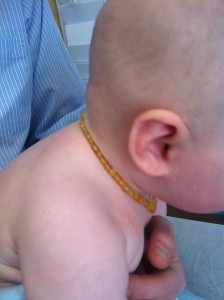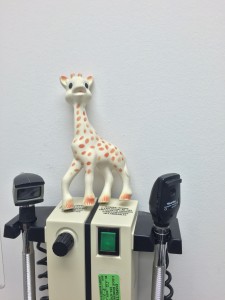In light of the recent recall of all lots of Hyland’s teething tablets because of safety concerns, we thought it was time to update parents about how to relieve teething pain.
About seven years ago, we started noticing amber bead necklaces adorning the necks of infants. We also noticed a plastic giraffe named Sophie. These relative newcomers were the latest in a long line of treatments that claim to soothe the discomfort of teething. Some work. Some don’t. And some are dangerous.
Ultimately, the best cure for teething discomfort is the emergence of a tooth. Until then, chewing on a safe toy or cool wash cloth and an occasional dose of acetaminophen or ibuprofen (if over six months old) can be helpful.
Be patient with teething. “Curing” teething does not cure all maladies. In fact, parents should be aware of these symptoms which are NOT caused by teething:
- Teething does not cause fever. Fever usually indicates infection somewhere: maybe a simple viral infection such as a cold, or maybe a more severe infection such as pneumonia, but parents should NOT assume that their baby’s fever is caused by teething. These babies could be contagious. Parents should not expose them to others with the false sense of security that they are not spreading germs
- Teething does not typically occur in four-month-olds. Usually the first teeth erupts at around six months of age. Some don’t get a tooth until their first birthday. Most drooling and mouthing behavior prior to six months, such as babies putting hands in their mouths, is developmental. Although you may not see a tooth erupt for a few months, babies at this age still enjoy gnawing on a toy.
- Teething does not cause diarrhea severe enough to cause dehydration. If a child has severe diarrhea, then he most likely has a severe stomach virus or another medical issue.
- Teething does not cause a cough severe enough to increase work of breathing. Babies make more saliva around four months of age and this increased production does result in an occasional cough. But babies never develop problems with breathing or a severe cough as a result of teething. Instead, suspect a cough virus or other cause of cough such as asthma.
- Teething does not cause pain severe enough to trigger a change in mental state. Some children get more cranky as their gums swell and redden with erupting teeth. But, if parents cannot console their crying/screaming child, the child likely has another, perhaps more serious, cause of pain and needs an evaluation by her pediatrician.
Safety Concerns
It’s not only the ingredients of teething tablets that we worry about. Many teething devices can turn into choking hazards. If you look at the consumer product safety recalls over the years, many toys are recalled because they have small pieces that can cause gagging or can come off and become a choking hazard.
We worry about amber bead necklaces and maternal teething jewelry. They fit all the potential safety hazard criteria. You never know when a bead will pop off and pose a choking hazard. A general rule of thumb is that anything that can easily fit through a toilet paper tube is small enough to get stuck in a baby’s airway. Additionally, any necklace on a baby could get caught and cause strangulation.
Also, the FDA has repeatedly warned against the use of topical anesthetics. Benzocaine gels can lead to methhemoglobinemia, a rare but serious and potentially fatal condition. Adults will sometimes use viscous lidocaine prescribed for themselves on a baby’s gums, but any numbness extending to the back of the throat can make it difficult for babies to swallow.
Interestingly, nearly every babyhood malady in the past has been blamed on teething, including seizures, meningitis, and tetanus. According to a 2009 article in Pediatrics in Review, teething was listed as the official cause of death in about five thousand infants in England in the early 1800s. In France from 1600 to 1900, fifty percent of all infant deaths were blamed on teething!
This truth we know for sure: teething causes teeth.
Julie Kardos, MD and Naline Lai, MD
©2017 Two Peds in a Pod®, updated from 2015





